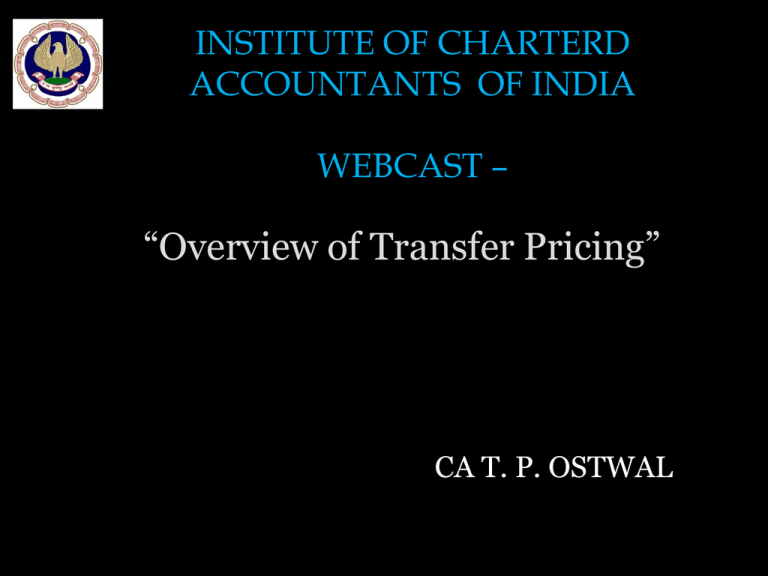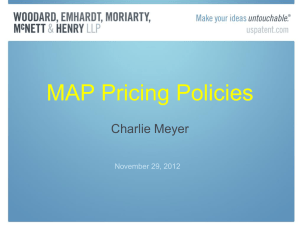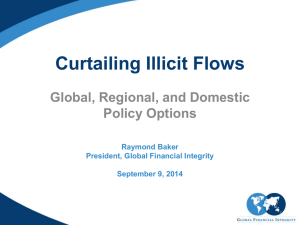Transfer Pricing Regulations in India * An Overview
advertisement

INSTITUTE OF CHARTERD ACCOUNTANTS OF INDIA WEBCAST – “Overview of Transfer Pricing” CA T. P. OSTWAL TRANSFER PRICING Brief history Post World War I What is Transfer Pricing? Basic Issues Underlying Transfer Pricing Evolution of Transfer Pricing Concepts in Transfer Pricing Transfer Pricing Methods Special Issues Related to Transfer Pricing Transfer Pricing in Treaties Transfer Pricing in Domestic Law Global Transfer Pricing Regimes Transfer Pricing as a Current and Future Issue for Developing Countries Indian Regulation on Transfer Pricing October 2013 October 2013 Where and why did the OECD/UN model treaty policy arise as it has? In 1920-1923, the ICC commenced a process to develop a model income tax treaty in the immediate aftermath of World War I. This was the period of conception for the model treaties of today. This work has been lost as the world has evolved. It is instructive with respect to the current tax policies being espoused by Source Countries. October 2013 The Post-World War I World (1920 – 1923) Imagine a world, long ago, in which the paradigm of commerce and international taxation was a developed country (let’s call it “England”) and an under-developed country that was a colony of England (“India”). A global war ended, with England having enormous war debt. There was a material flow of commerce between England and India. For the most part, England transferred to affiliates in India capital, technology, and access to global markets. India responded with commodities and produced goods. England was a creditor and India a debtor. The policy issue for consideration was how income from these activities should be shared between “Resident” and “Source” countries. October 2013 ICC Proposal in 1923 In its interim report in 1923, the ICC proposed what we would call today a profit split or formulary allocation methodology to address income allocation between Residence (Creditor) and Source (Debtor) countries. Rather close to the combined income methodologies that we typically use today to resolve major CA cases between countries with an MNE in the middle. Frankly, it is also similar to the methodologies for evaluating intangibles in the 2012 OECD discussion draft. League of Nations (1923 – 1928) The ICC work was taken over by the League of Nations in 1923. The LofN took an entirely different approach. It formulated 5 principles: October 2013 League of Nations (1923 – 1928) cont… 1. Source Country (India) should tax local operations, including property or other pertinent matters. 2. Residual income should be earned by the country of Residence, which provided the knowledge and capital for the business. 3. Presence of an interim holding company should be treated as a Residence Country. Why was this assumed?: All countries would adopt a common model! 4. Subsidiaries should not be treated as a PE. 5. TP is to be evaluated on a consistent basis. The model treaties that eventually became the OECD Model, and subsequently the UN Model, are based on these 5 principles. October 2013 What was the net impact of these principles? Answer: A system that allowed: 1.Source Country earns a routine return. 2.Residence Country receives the residual income. 3.Interim holding companies would be treated as Residence Countries, even if located in a low tax country. October 2013 MNE Tax Planning Strategies Not surprisingly, the international tax and effective tax rate (“ETR”) strategies of MNEs evolved based on this treaty model. Common structures included what we today describe as: 1.Global/regional principal 2.Centralized risk-taker, intangibles owner 3.Limited risk activities in high tax countries October 2013 Effective Tax Rates (‘ETR‘) strategies are often based on easily applied one-sided TP methodologies, which typically test the earnings of Source Country affiliates. These strategies are precisely what was contemplated in the work of the LofN, which is the model of OECD/UN model treaties. Today, MNEs are commonly pilloried for base stripping Source Countries. October 2013 Imperial Paradigm October 2013 Present Day Scenario Foreign Parents Intermediate Holding Company Costa Rica BVI Supply Chain Transaction Cayman Island Interest transfer payments Developing Countries Bermuda Luxembourg Lease transfer payments Royalty transfer payments October 2013 ANATOMY OF INCOME SHIFTING (BASE EROSION) Tax Havens & many more… October 2013 Is the criticism appropriate? Whether this answer is “yes” or “no,” it is apparent to me that this is the behavior that was encouraged by the LofN model. At the time, it may have been intended to facilitate repatriation of revenue to Residence countries to repay war debts. October 2013 October 2013 Introduction to Transfer Pricing Rise to a large number of multinational enterprises (MNEs) Rise of intra group trade – including highly complex international transactions involving intangibles and multitiered services MNE transaction structure determined not only by open market but also by group driven forces inclined towards the common interests of the entities of a group Determination of transfer price becomes imperative Transfer price to be determined on arms length basis Transfer pricing therefore refers to the setting of prices (arms length price) for transactions between associated enterprises the transfer of property or services October 2013 Concept of transfer pricing – Example 1 Purchase of computer from S Co “Controlled Transaction” Purchase of computer from third party “Uncontrolled Transaction” Country A ABC H Co Country B ABC S Co XYZ Transfer price of controlled transaction to be equivalent to market price of a comparable uncontrolled transaction; If lower, Country B loses revenue. October 2013 Concept of transfer pricing – Example 2 Illustration: PQR S Co is the distributor of PQR H Co’s watches in Country B PQR H Co Country A Manufacturing Cost to Hco. $1400 Distribution Cost to SCo. Transfer price Sale price in Country B H Co Profit S Co Profit Country B $100 $1500 $1600 $100 PQR S Co NIL (Cost =Revenue) Tax authorities of Country B insists that S Co should atleast report a profit of $100; thus transfer price to be reduced to $1,400 – Leads to economic double taxation. Customers October 2013 Transfer Pricing and Business Enterprises Pricing multiple transactions with associated entities in different tax jurisdictions Measurement of performance of the individual entities in a MNE MNE intra-group transactions are undertaken only of its profitable Identifying and valuing intangibles transferred and services provided Transfer price of non-accounted intangibles Transfer price of intra department transactions October 2013 Basic issues underlying Transfer Pricing Cross border tax situations involve issues related to jurisdiction, allocation of income and valuation. A MNE Group may exploit the opportunity to shrink the overall tax burden of the group through either under-charging or over-charging the associated entity for intra-group trade: Illustration: Tax rate in the resident country A of HCo. 30% Tax rate in the resident country B of SCo. 20% HCo shifts profits from Country A to Country B through HCo. being over-charged for the acquisition of property and services from SCo. A group may transfer the tax loss of an associated enterprise in a jurisdiction where losses cannot be carried forward beyond the prescribed time limit to a jurisdiction without such restrictions so as to fully utilize the same. In some cases loss may be transferred to take the benefit of deductions as quickly as possible. Evidently profits may sometimes be shifted to certain countries in order to obtain specific tax benefits. Reduction of taxation not the only factor contributing to the transfer pricing policies and practices of a MNE Group October 2013 Basic issues underlying Transfer Pricing The key issues in jurisdiction: Which country should tax the income of the group entities engaged in the transaction? What happens if both countries claim the right to tax the same income? If the tax base arises in more than one country, should one of the country’s give tax relief to prevent double taxation of the relevant entities’ income, and if so, which one? What needs to be done to minimise profit shifting from one country to another? The key issues in valuation: Valuation of intra-group transfers that are prone to manipulations With the MNE being an integrated structure with the ability to exploit international differentials and to utilise economies of integration not available to a stand- alone entity, transfer prices within the group are unlikely to be the same prices that unrelated parties would negotiate October 2013 Basic issues underlying Transfer Pricing The key issues in allocation of income: MNE’s Optimal allocation of common resources and overheads and achieve competitive advantage Reduction of transaction cost Government Expand tax base Transfer pricing rules are essential for countries (for Tax administration and Tax Payers) in order to - Protect their tax base; - Eliminate double taxation ; and - Enhance cross border trade October 2013 Evolution of Transfer Pricing • US • First country to adopt a comprehensive transfer pricing legislation in 1968. • OECD • Reports on transfer pricing in 1979 and 1984 • issued the TP Guidelines in 1995 as amended by 2010 version •United Nations (UN) •Report on “International Income Taxation and Developing Countries” in 1988. • The UN Conference on Trade and Development (UNCTAD) also issued a major report on Transfer Pricing in 1999. • The United Nations (UN) is again taking a leadership role, through its Transfer Pricing Manual, in trying to arrive at updated global transfer pricing guidance which can be used by countries all over the world in developing (or calibrating) their transfer pricing regulations. •European Commission (EC) • Proposals on income allocation to EC members of MNEs October 2013 Concepts in Transfer Pricing • Transactions with related parties must be based on the “arm’s length principle” (ALP) • Arm’s length principle” (ALP) • Origins in Contract law • to arrange an equitable agreement that will stand up to legal scrutiny, even though the parties involved may have shared interests. • Not specifically used in Article 9 of both OECD MTC and UN MTC. However it is well accepted by countries as encapsulating the approach taken in Article 9 with some differing interpretations. October 2013 Concepts in Transfer Pricing (contd)... • Using the arm's length principle • Argument in favour • Geographically neutral, as it treats profits from investments in a similar manner • An alternative to the arm’s length principle • Global Formulary Apportionment method • Currently used by • Some states of USA, • Cantons of Switzerland and • Provinces of Canada. • EU is also considering a formulary approach - Common Consolidated Corporate Tax Base (CCCTB) and home state taxation October 2013 Special Issues Related to Transfer Pricing 1. Intangibles • Trade intangibles • such as know-how relate to (production of goods and the provision of services) • 2. Marketing intangibles (aid in the commercial exploitation of a product or service) • Trade names, • Trademarks and • Client lists Intra-group services - Financial Services (guarantee fees, etc.) - Managerial, - legal, - accounting and finance, - credit and collection, - training and personnel management services. October 2013 Special Issues Related to Transfer Pricing 3. Cost – Contribution Agreements • Jointly develop, produce or obtain rights, assets or services. 4. Use of “secret comparables” October 2013 Transfer Pricing in Domestic Law Time limitations For TP adjustments possible India vis a vis other countries May lead to double taxation Safe harbours Dispute Prevention Measure Advance Pricing Agreements Transfer Pricing and / or Controlled foreign corporation provisions If both applicable – Then first preference to be given to which provisions If only TP is applicable, whether bringingCFC is necessary – as both are anti avoidance provisions. Necessity of domestic transfer pricing rules. October 2013 Transfer Pricing in Treaties • Corresponding adjustments - To avoid economic double taxation eg. Section 482 of Under Section 482 of the Internal Revenue Code (IRC) of U.S • Transfer pricing dispute resolution mechanism • Mutual Agreement Procedure (MAP) – in Article 25. • Arbitration to resolve transfer pricing disputes. • The EU Arbitration Convention October 2013 Global Transfer Pricing Regimes By the end of 2011 there were around 100 countries with some form of specific transfer pricing legislation as shown by the red shading in the diagram below October 2013 Global Transfer Pricing Regimes ….(contd) Countries where Transfer Pricing Regulations are in existence Argentina Canada Czech Republic Estonia Hungary Italy Latvia Namibia Panama Romania South Africa Thailand Venezuela Australia Chile Denmark Finland India Japan Lithuania Netherlands Peru Russia Spain Turkey Vietnam Austria China Dominican Republic France Indonesia Kenya Luxembourg New Zealand Philippines Singapore Sweden United Kingdom Belgium Colombia Ecuador Germany Ireland Korea, North Malaysia Norway Poland Slovakia Switzerland United States Brazil Croatia Egypt Hong Kong Israel Korea, South Mexico Oman Portugal Slovenia Taiwan Uruguay Countries where Transfer Pricing Regulations is still emerging Algeria Belarus Cambodia Gambia Kazakhstan Malawi Morocco Pakistan Angola Bolivia Cote d'Ivoire Georgia Kuwait Mali Mozambique Papua New Guniea Armenia Botswana Cyprus Ghana Liberia Mauritania Netherlands Antilles Qatar Aruba Bulgaria El Salvador Greenland Libya Mauritius Nicargua Senegal Bangladesh Burkina Faso Ethiopia Iceland Macedonia Mongolia Nigeria Sierra Leone Sri lanka Trinidad and Tobago Ukraine Uzbekistan Zambia Zimbabwe October 2013 Specific challenges – Developing Countries face in dealing effectively with Transfer Pricing Issues • Lack of comparables • Lack of knowledge and requisite skill-sets • Complexity to administer • Growth of the “E-commerce economy”- various ways in which transactions can be done • Location savings October 2013 Part II. The Indian TP Regime Indian TP provisions • Indian TP provisions were introduced under “Chapter X : Special Provisions Relating to Avoidance of Tax” – Chapter X, Section 92 of the Income Tax Act (1961) and Rule 10A-D of the Income Tax Rules (1962) – TP regime was introduced via Finance Bill 2001 w.e.f April 1st 2001. – In other words, India is a relatively new entrant into the TP vortex! • Birds-eye, one-line overview of Indian TP: – Run-of-the-mill TP provisions, OECD-lite and delightfully vague (like most TP provisions)! October 2013 Indian TP Provisions – Section 92 Section & Rules Provisions 92 Computation of income having regard to ALP 92A Meaning of Associated Enterprise 92B Meaning of International transaction 92BA Meaning of specified domestic transactions 92C (1) Methods of computation of ALP (Rule 10B, 10C) *Rule 10AB – Any other method for determination of ALP 92CA Reference to Transfer Pricing Officer (TPO) 92CB Safe harbour rules 92CC Advance Pricing agreement 92CD Effect of advance pricing agreement 92D (Rule 10D) Maintenance of information and documents by persons entering into an international transaction or specified domestic transaction 92E (Rule 10E, Form 3CEB) Accountant’s Report entering into an international transaction or specified domestic transaction 92F (Rule 10A) Definitions: Accountant, ALP, Enterprise, PE, Specified date, Transaction * * Sec 92F – Definitions does not define terms relevant for domestic TP transactions October 2013 Transfer Pricing Penal provisions (a.k.a ‘rubbing salt into the wound’) Sr. No. 1 Type of penalty Section Penalty quantified 271AA 2% of transaction value 271G 2% of transaction value 271(1)(c) 100% to 300% of tax on adjustment amount a) Failure to maintain prescribed information/ documents (b) Failure to report any such transaction or (c) Furnish incorrect information 2 Failure to furnish information/ documents during assessment u/s 92D 3 Adjustment to taxpayer’s income during assessment 4 Failure to furnish accountant’s report u/s 92E 271BA INR 100,000 October 2013 Indian TP vs. OECD Guidelines Snapshot view* Concepts Indian regulations OECD Guidelines Associated Enterprises Very wide definition Restricted to controlled entities Comparable range (FY 2013)Allows 3% range band on Allows for range of avg. results of comparables comparable data Multiple year data Only allows data for current year (and earlier 2 years under limited circumstances) Permitted Foreign comparables Not permitted in practice Permitted Priority of methods Most appropriate method rule (Originally) preference for traditional methods Use of unspecified method Now specified Permitted Documentation Stringent Prudent business principles Intangibles definition vegue and unclear No guidelines Defined and described but progress still not full achieved. * Modified version of table in ‘Transfer pricing Law and Practice in India – a fine print analysis’ October 2013 Indian TP Assessment & Litigation Assessment timeline example 2011+ Supreme Court 2011+ High Court May 2011 Income Tax Appellate Tribunal (ITAT) Appeal against CIT(A) order Appeal against Final Asst. Order May 2010 Commissioner of Income Tax (Appeals) Set-aside / Remanded back to AO Dispute Resolution panel (DRP) Appeal against Asst. order Appeal against Draft Asst. order AO:Dec. 2009 TPO reference Assessing Officer (AO) Form 3CEB TPO Order u/s 92CA(3) Transfer Pricing Officer (TPO) Specified transaction U/S 92BA T.P.Ostwal & Associates TPO: Dec. 2008 Sept.2006 FY 2005-06 Part III. Specified Domestic Transactions TP was earlier limited to ‘International Transactions’ The Finance Act 2012, extends the scope of TP provision to ‘Specified Domestic Transactions’ between related parties w.e.f. 1 April 2012 The Supreme Court in the case of CIT vs Glaxo Smithkline Asia Pvt Ltd [2010-195Taxman 35 (SC)] recommended introduction of domestic TP provisions SDT previously reported/certified but onus was on revenue authorities Obligation now on taxpayer to report/ document and substantiate the arm’s length nature of such SDT transactions Shift from generic FMV concept to focused ALP concept These new provisions would have ramifications across industries which benefit from the preferential tax policies such as SEZ units, infrastructure developers or operators, telecom services, industrial park developers, power generation or transmission etc. Apart from this, business conglomerates having significant domestic intra-group transactions would be largely impacted October 2013 Overview of Provisions of Section 92BA Inter unit transfer of goods & services by undertakings to which profit-linked deductions apply Expenditure incurred between related parties defined under section 40A SDT Transactions between undertakings, to which profit-linked deductions apply, having close connection October 2013 Any other transaction that may be specified THANK YOU October 2013






